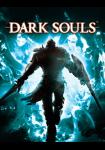
Dark Souls - Editorial @ Gamasutra
Gamasutra's has a new blog post that talks about narrative design in Dark Souls.
This post doesn't contain any spoilers for any of the Souls games, so rest easy, fellow undead.
I've been meaning to write about the Souls series' unique approach to narrative design for a while, but, well, I've been playing too much Dark Souls II. But as I'm bearing down on what must be the end of a 70-ish-hour playthrough I figure now is as good a time as any to discuss the way these games tell their stories.
I remember first playing through Demon's Souls back in 2009 and thinking to myself 'this game is awesome, but would be way more awesome with a proper story.' It seemed at the time to be a game heavy with atmosphere, but light on storytelling.
By 'proper story' I meant the way most roleplaying games deliver their narrative; via dialogue, cutscenes and text dumps. Wouldn't it be better, stupid, unperceptive 2009 me thought, if Demon's Souls featured lengthy dialogues with its characters, cutscenes depicting their exploits, and Elder Scrolls style text books to expound its lore?
No, 2009 me. It wouldn't be better. It took me a few playthroughs of Dark Souls before I really understood how elegant the story design is in these games, and how much more interesting this approach is than that employed by most other games in the genre.
In the Souls games, the narrative is woven directly into the world of the game. There are three primary ways the player can access narrative information; through the dialogue spoken by non-player characters, in the descriptions of the items found strewn across the world, and from the visual design of the world itself. Only by engaging with all three of these narrative devices can a player begin to get a wider picture of the game's larger story.
Information about
Dark SoulsSP/MP: Single + MP
Setting: Fantasy
Genre: Action-RPG
Platform: PC
Release: Released

